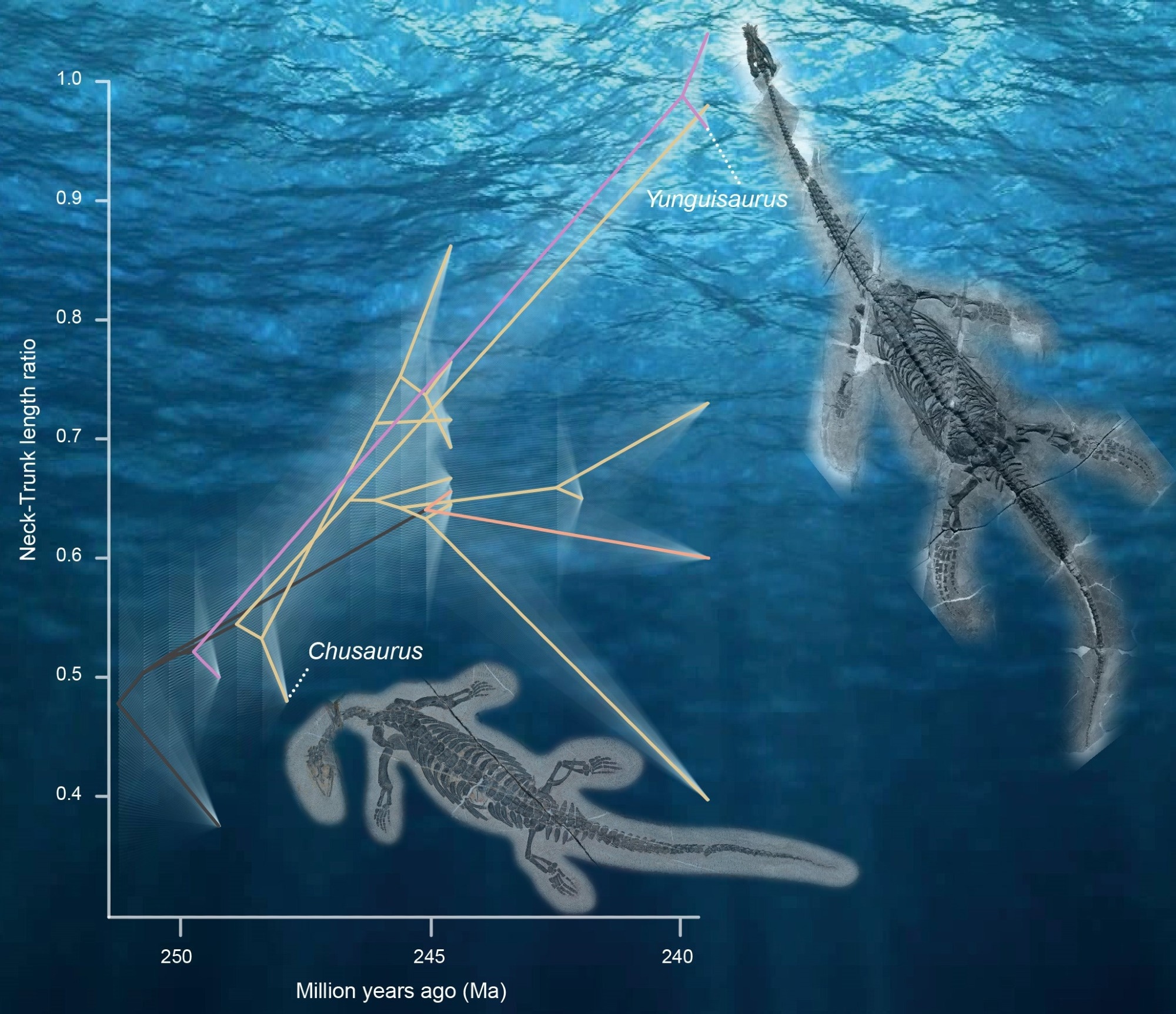Reviewed by Danielle Ellis, B.Sc.Sep 5 2023
The research, conducted by experts in China and the UK and published on September 4th, 2023 in BMC Ecology and Evolution, reveals that the pachypleurosaur species elongated their necks mostly by adding additional vertebrae. While some Late Cretaceous plesiosaurs, such as Elasmosaurus, had up to 72 vertebrae, one species, Pachypleurosaur, only had 25, and its neck was five times longer than its trunk.
 Image showing fast rates of evolution and the specimens. Image Credit: Qi-Ling Liu
Image showing fast rates of evolution and the specimens. Image Credit: Qi-Ling Liu
The animals appeared four million years after the end-Permian mass extinction, which wiped off over 90% of Earth's species, and during a period of rapid change after the tragedy.
The researchers report Chusaurus xiangensis, a new short-necked plesiosaur progenitor from the Early Triassic of Hubei Province, China. Its neck has begun to develop, although it is barely half the length of its body’s trunk, compared to 80% or higher in later relatives.
We were lucky enough to find two complete skeletons of this new beast. It is small, less than half a meter long, but this was close to the ancestry of the important group of marine reptiles called Sauropterygia. Our new reptile, Chusaurus, is a pachypleurosaur, one of a group of small marine predators that were very important in the Triassic. I wasn’t sure at first whether it was a pachypleurosaur though because the neck seemed to be too short.”
Qi-Ling Liu, Study Lead, China University of Geosciences
Dr Li Tian, also of China University of Geosciences Wuhan, who co-supervised the project, stated, “This has been very heavily studied in recent years as one of the oldest assemblages of marine reptiles from the Triassic. We have good quality radiometric dates showing the fauna is dated at 248 million years ago.”
Collaborator Professor Michael Benton of the University of Bristol’s School of Earth Sciences said: “The end-Permian mass extinction had been the biggest mass extinction of all time and only one in twenty species survived. The Early Triassic was a time of recovery and marine reptiles evolved very fast at that time, most of them predators on the shrimps, fishes and other sea creatures. They had originated right after the extinction, so we know their rates of change were extremely rapid in the new world after the crisis.”
Professor Cheng Long, of the Wuhan Centre of China Geological Survey, a co-supervisor, noted, “The pachypleurosaur lengthened their necks mainly by adding new vertebrae. Normally, vertebrates like reptiles and mammals (and us) have seven neck vertebrae. Chusaurus already had 17, whereas later pachypleurosaur had 25. Some Late Cretaceous plesiosaurs such as Elasmosaurus even had 72, and its neck was five times the length of its trunk. With so many vertebrae, these long necks must have been super-snakey and they presumably whipped the neck around to grab fishy prey while keeping the body steady.”
Dr Tom Stubbs of the Open University UK added, “Not all long-necked animals do it in the same way. Giraffes for example keep the standard seven neck vertebrae, but each one is very long, so they can reach high into the trees. Flamingos also have long necks so they can reach the water to feed, because of their long legs, and they have extra vertebrae, up to twenty, but each one is also long.”
Dr Ben Moon, from the University of Bristol, added, “Our study shows that pachypleurosaur doubled the lengths of their necks in five million years, and the rate of increase then slowed down. They had presumably reached some kind of perfect neck length for their mode of life. We think, as small predators, they were probably mainly feeding on shrimps and small fish, so their ability to sneak up on a small shoal, and then hover in the water, darting their head after the fast-swimming prey was a great survival tool. But there might have been additional costs in having a much longer neck, so it stabilized at a length just equal to the length of the trunk.”
Source:
Journal reference:
Liu, Q.-L., et al. (2023). Rapid neck elongation in Sauropterygia (Reptilia: Diapsida) revealed by a new basal pachypleurosaur from the Lower Triassic of China. BMC Ecology and Evolution. doi.org/10.1186/s12862-023-02150-w